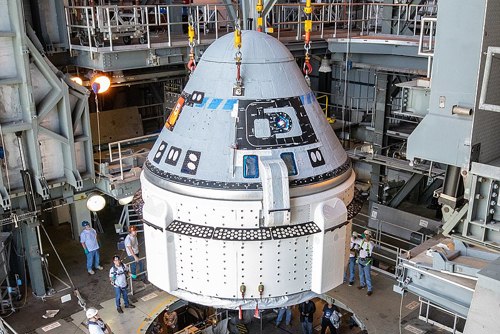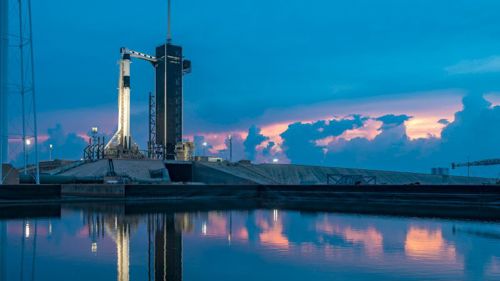What's Happening in Space: May 2024
- 30th Apr 2024
We've got a bumper edition of our monthly space happenings blog for you this May, why not use it to inspire your own learning and star gazing - there are plenty of exciting events to find out about and you can use the links to delve deeper. As always, Dhara Patel, Space Expert at the National Space Space, is your guide to the universe...

3rd May – Launch of Chang’e 6 mission
Chang'e 6 is China's second lunar soil sample return mission similar to Chang'e 5 which launched in late 2020. The launch is planned for 8:00am UK-time on 3rd May and will lift off on a Long March 5 rocket from Wenchang Space Launch Site in China. The space probe is expected to bring back to Earth a lunar soil sample with a mass of up to two kilograms. The lander will land on the far side of the Moon, near the southern edge of the Apollo Basin. If the mission objective is completed, it would be the first soil sample from the far side of the Moon ever returned to Earth. During its 53-day mission, with no direct contact with Earth, Chang'e-6 will rely on a relay satellite orbiting the Moon for communications. It’s also the first Chinese lunar mission in cooperation with another country (France) and will see French scientific instruments land on the Moon for the first time since the Soviet Luna program. Find out more about the Chang’e 6 mission and China’s lunar exploration program in this blog written by Katie Holland in our Space Comms team: https://www.spacecentre.co.uk/news/space-now-blog/chinese-lunar-exploration-program/
4th May – Close approach of the Moon and Saturn (and ISS pass)
In the late evening hours of 3rd May, the waning crescent moon will be in conjunction (sharing the same right ascension – coordinate) with Saturn, but will be below the horizon at this time, so not visible from the UK. Instead try to catch the Moon and Saturn in close approach just before sunrise on 4th May. They’ll be really low on the eastern horizon so you’ll need a very clear view without tall buildings or trees that may block your view. On 31st May, the Moon will again be in conjunction with Saturn (but during daylight hours and therefore impossible to see) – so catch the pair in the southeast in close approach instead, before the sun rises on that morning. As a bonus, around 4:20am, the International Space Station will be passing overhead looking like a bright star – over 7 minutes it will travel steadily from the west over to the south-east, near the Moon and Saturn, where it will set. Find out more about conjunctions, close approaches and other astronomical phenomena in our blog written by David Southworth in our Education Team: https://www.spacecentre.co.uk/news/space-now-blog/astronomical-phenomena/

5th May – Close approach of the Moon and Mars
Similarly, to the Moon and Saturn, in the early hours of the morning of 5th May, the even thinner waning crescent moon will be in conjunction (sharing the same right ascension – coordinate) with Mars but will again be below the horizon at this time, so not visible from the UK. Instead try to catch the Moon and Mars in close approach just before sunrise on this day. They’ll be even lower on the eastern horizon so you’ll need an extremely clear view without tall buildings or trees that may block your view. Check out the astronomical phenomena blog linked above to find out more about conjunctions and close approaches.
5th-6th May – peak of the Eta Aquariid meteor shower
A moderate shower, ~ 50 meteors per hour at its peak, produced by dust left behind by Halley’s Comet. The meteors will radiate from the constellation Aquarius (appearing in the east in the early hours of the morning) but can be seen anywhere in the sky. Peaking between midnight and the early hours of the 6th, the waning crescent moon will be below the horizon for most of the night, so moonlight interference won’t be a factor that affects visibility. Best viewing will be from a dark location after midnight. The radiant will continue to rise higher into the sky during the early morning of the 6th, so it might be best to head out after midnight and look until just before sunrise when the radiant will begin to creep above the eastern horizon. If you miss the peak, the shower is active between 19th April and 28th May. You can find out more about the Eta Aquariid meteor shower and how to catch it in this blog written by Lucy Spencer in our Community Team: https://www.spacecentre.co.uk/news/space-now-blog/eta-aquariid-meteor-shower-2024/

7th May – Boeing CST-100 Starliner spacecraft's Crew Flight Test
Boeing's CFT (Crew Flight Test) with the Starliner spacecraft is scheduled to launch (on a United Launch Alliance Atlas V rocket) at 3:34am on 7th May from Cape Canaveral Space Force Station, USA – the first launch of humans from there since Apollo 7 in October 1968. Boe-CFT will be the first crewed mission of the Boeing Starliner spacecraft (journeying to the International Space Station for a one-week mission) and the third orbital flight test of the Starliner overall after the two uncrewed orbital flight tests, Boe-OFT and Boe-OFT 2 in 2019 and 2022. Starliner is Boeing’s equivalent of SpaceX’s Crew Dragon spacecraft – both companies were selected for NASA’s commercial crew program to take crew to the ISS. Whereas SpaceX has completed testing and been launching crew to the ISS on behalf of NASA since 2020 (with the latest crew launching on 4th March 2024 – Crew 8), Boeing are yet to conduct a successful crewed test. Check out this blog about Boeing Starliner written by Catherine Muller and Mike Darch in our Space Comms Team: https://www.spacecentre.co.uk/news/space-now-blog/boeing-starliner/
8th May – new moon (4:21am)
The new moon on 8th will occur in the constellation of Aries. We have a blog on ‘phases of the moon’ written by Mike Darch in our Space Comms team: https://spacecentre.co.uk/blog-post/moon-phases/
9th May – Mercury at greatest western elongation
Mercury will be at its furthest separation from the Sun on 9th May when it reaches greatest western elongation, making it a great time to try and spot the Sun’s closest planet. Look to the east around sunrise – it will be close to the horizon, so you’ll need a clear view without tall buildings and trees. Check out the astronomical phenomena blog linked above to find out more about greatest elongations.
23rd May – full moon (2:43pm)
Known as the Flower moon (according to the old Farmers’ Almanac), this full moon is named after the abundance of flowers that bloom as spring truly gets underway. Check out the “Full Moon: Full Facts” blog written by Mike Darch in our Space Comms team: https://spacecentre.co.uk/blog-post/full-moon-facts/.
The following events don't yet have exact dates assigned but should be getting underway this May!
May?? – Virgin Galactic's Galactic-07 mission
VSS Unity (the crewed spacecraft) will aim for suborbital flight through the help of a double-bodied carrier aircraft called VMS Eve, which will take off from a runway at Spaceport America. Once at an altitude around 15km, VSS Unity will release from VMS Eve, after which it will fire its rocket engine and travel the rest of the way to space on its own reaching an altitude of roughly 85km – higher than the Karman line / boundary of space as defined by NASA. The suborbital flight will last long enough to grant the Galactic 07 crew members a few minutes of weightlessness. Post-flight reviews of the last mission showed that an alignment pin detached from the launch pylon of our mothership, VMS Eve, during flight. The Federal Aviation Administration (FAA) were notified. At the completion of the review of this incident Virgin will provide an update and will confirm the flight window for the ‘Galactic 07’ mission, which is planned for the second quarter of 2024. The crew have yet to be announced but will carry four customers – a mix of researchers and private astronauts. Galactic 07 may also be the final flight of VSS Unity. The company plans to halt flights of the spaceplane in the middle of the year to focus its resources on development of the Delta class of suborbital vehicles. The new spacecraft will be larger and able to carry six passengers on board rather than Unity’s four-person capacity and will require less maintenance between flights, rendering it capable of launching up to twice a week (compared to Unity’s once a month capability).
May?? – Blue Origin New Shepard | NS-25 mission
NS-25 will be a crewed sub-orbital spaceflight mission, operated by Blue Origin. The crew will launch on a New Shepard rocket from Launch Site One in West Texas. NS-25 will be the first crewed New Shepard flight since NS-22 in August 2022 when the fleet was grounded after an engine failure on an uncrewed mission in September 2022. The six-person crew will include Mason Angel, Sylvain Chiron, Kenneth L. Hess, Carol Schaller, Gopi Thotakura, and former Air Force Captain Ed Dwight, who was selected by President John F. Kennedy in 1961 as the nation’s first Black astronaut candidate but was never granted the opportunity to fly to space. This mission will be the seventh human flight for the New Shepard program and the 25th in its history. To date, the program has flown 31 humans above the Kármán line.

May?? – SpaceX Starship – Test Flight 4
Starship is made of the Super Heavy booster – a first stage rocket with 33 of SpaceX’s raptor engines and on top of that sits the upper stage, rather confusingly also called Starship, which hosts 6 engines. And when its fully developed it will be a completely reusable rocket – both first and second stages.
- The first test flight of the fully integrated Starship rocket took place on 20th April 2023 - the upper stage failed to separate from the booster a few minutes into its flight and SpaceX experienced a ‘rapid unscheduled disassembly’ a.k.a. RUD / an explosion.
- During the second test flight on 18th November 2023 the stages separated but shortly after, the first stage had multiple engine failures and after beginning its boost back burn, ended up exploding. Meanwhile the Starship second stage continued to fly for over 8 minutes, but an anomaly caused the flight termination system to kick in, so it too was destroyed after reaching an altitude of 148 km.
- The third test flight on 14th March 2024 was more successful with the first stage and second stage separating successfully. The Super Heavy first stage then returned to Earth and lit several engines for its first ever landing burn, before the vehicle experienced a RUD about 462m in altitude after just under seven minutes into the mission. Starship’s second stage completed its ascent burn, then opened and closed its payload door and initiated a propellant transfer demonstration. It then underwent re-entry with live views showing the heating experienced due to the hypersonic speeds on descent. The ship experienced a heavy roll causing SpaceX to lose attitude control, resulting in the loss of the vehicle with last telemetry received around 49 minutes into the flight.
- Test flight 4 is currently scheduled for May 2024 but could be delayed as we’ve seen with previous test flight schedules. Both vehicles will have been further adapted for this flight based on any faults detected during Flight Test 3.
Find out more about Starship and SpaceX’s other rocketry achievements in this blog by Ed Turner in our Education team: https://www.spacecentre.co.uk/news/space-now-blog/spacex-the-world-s-rocket-giant/
May?? – EarthCARE mission
Scheduled to launch in May from Vandenberg Space Force Base, USA on a Falcon 9 rocket, EarthCARE is a planned joint European (ESA) and Japanese (JAXA) satellite in cooperation with the National Institute of Information and Communications Technology (NICT), and is the sixth of ESA's Living Planet Programme. The main goal of the EarthCARE (Earth Clouds, Aerosol and Radiation Explorer) mission is the observation and characterization of clouds and aerosols as well as measuring the reflected solar radiation and the infrared radiation emitted from Earth's surface and atmosphere. During its 3-year planned lifetime, it will travel in a sun-synchronous orbit at an altitude of roughly 393km - low enough to optimise the use of its lidar and radar instruments, but still high enough where atmospheric drag won’t impact fuel consumption and the life of the mission too much.
Please note: As this summary is created at the end of the month before, dates (especially launch dates) can often change or be updated, so this content may become outdated - we always recommend checking on the relevant organisation's pages.
